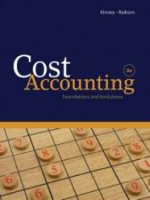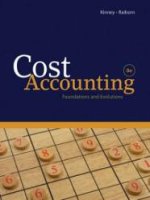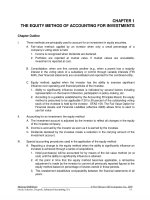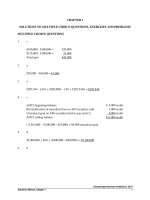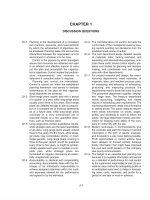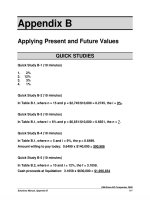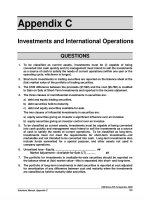Solution manual financial accounting 8e by libby ch01
Bạn đang xem bản rút gọn của tài liệu. Xem và tải ngay bản đầy đủ của tài liệu tại đây (700.19 KB, 32 trang )
Find more at www.downloadslide.com
Chapter 01 - Financial Statements and Business Decisions
Chapter 1
Financial Statements and Business Decisions
ANSWERS TO QUESTIONS
1. Accounting is a system that collects and processes (analyzes, measures, and
records) financial information about an organization and reports that information to
decision makers.
2. Financial accounting involves preparation of the four basic financial statements and
related disclosures for external decision makers. Managerial accounting involves
the preparation of detailed plans, budgets, forecasts, and performance reports for
internal decision makers.
3. Financial reports are used by both internal and external groups and individuals. The
internal groups are comprised of the various managers of the entity. The external
groups include the owners, investors, creditors, governmental agencies, other
interested parties, and the public at large.
4. Investors purchase all or part of a business and hope to gain by receiving part of
what the company earns and/or selling the company in the future at a higher price
than they paid. Creditors lend money to a company for a specific length of time and
hope to gain by charging interest on the loan.
5. In a society each organization can be defined as a separate accounting entity. An
accounting entity is the organization for which financial data are to be collected.
Typical accounting entities are a business, a church, a governmental unit, a
university and other nonprofit organizations such as a hospital and a welfare
organization. A business typically is defined and treated as a separate entity
because the owners, creditors, investors, and other interested parties need to
evaluate its performance and its potential separately from other entities and from its
owners.
6.
Name of Statement
(a) Income Statement
(b) Balance Sheet
(c) Audit Report
Financial Accounting, 8/e
Alternative Title
(a) Statement of Earnings; Statement of
Income; Statement of Operations
(b) Statement of Financial Position
(c) Report of Independent Accountants
1-1
© 2014 by McGraw-Hill Global Education Holdings, LLC. This is proprietary material solely for authorized instructor use. Not authorized for sale or distribution in
any manner. This document may not be copied, scanned, duplicated, forwarded, distributed, or posted on a website, in whole or part.
Find more at www.downloadslide.com
Chapter 01 - Financial Statements and Business Decisions
7. The heading of each of the four required financial statements should include the
following:
(a) Name of the entity
(b) Name of the statement
(c) Date of the statement, or the period of time
(d) Unit of measure
8. (a)
(b)
(c)
(d)
The purpose of the income statement is to present information about the
revenues, expenses, and the net income of the entity for a specified period of
time.
The purpose of the balance sheet is to report the financial position of an entity
at a given date, that is, to report information about the assets, obligations and
stockholders’ equity of the entity as of a specific date.
The purpose of the statement of cash flows is to present information about the
flow of cash into the entity (sources), the flow of cash out of the entity (uses),
and the net increase or decrease in cash during the period.
The statement of stockholders’ equity reports the changes in each of the
company’s stockholders’ equity accounts during the accounting period
including issue and repurchase of stock and the way that net income and
distribution of dividends affected the retained earnings of the company during
that period.
9. The income statement and the statement of cash flows are dated ―For the Year
Ended December 31, 2013,‖ because they report the inflows and outflows of
resources during a period of time. In contrast, the balance sheet is dated ―At
December 31, 2013,‖ because it represents the resources, obligations and
stockholders’ equity at a specific date.
10. Assets are important to creditors and investors because assets provide a basis for
judging whether sufficient resources are available to operate the company. Assets
are also important because they could be sold for cash in the event the company
goes out of business. Liabilities are important to creditors and investors because
the company must be able to generate sufficient cash from operations or further
borrowing to meet the payments required by debt agreements. If a business does
not pay its creditors, the law may give the creditors the right to force the sale of
assets sufficient to meet their claims.
11. Net income is the excess of total revenues over total expenses. Net loss is the
excess of total expenses over total revenues.
12. The equation for the income statement is Revenues - Expenses = Net Income (or
Net Loss if the amount is negative). Thus, the three major items reported on the
income statement are (1) revenues, (2) expenses, and (3) net income.
1-2
Solutions Manual
© 2014 by McGraw-Hill Global Education Holdings, LLC. This is proprietary material solely for authorized instructor use. Not authorized for sale or distribution in
any manner. This document may not be copied, scanned, duplicated, forwarded, distributed, or posted on a website, in whole or part.
Find more at www.downloadslide.com
Chapter 01 - Financial Statements and Business Decisions
13. The equation for the balance sheet (also known as the basic accounting equation)
is: Assets = Liabilities + Stockholders’ Equity. Assets are the probable (expected)
future economic benefits owned by the entity as a result of past transactions. They
are the resources owned by the business at a given point in time such as cash,
receivables, inventory, machinery, buildings, land, and patents. Liabilities are
probable (expected) debts or obligations of the entity as a result of past
transactions which will be paid with assets or services in the future. They are the
obligations of the entity such as accounts payable, notes payable, and bonds
payable. Stockholders’ equity is financing provided by owners of the business and
operations. It is the claim of the owners to the assets of the business after the
creditor claims have been satisfied. It may be thought of as the residual interest
because it represents assets minus liabilities.
14. The equation for the statement of cash flows is: Cash flows from operating activities
+ Cash flows from investing activities + Cash flows from financing activities =
Change in cash for the period. The net cash flows for the period represent the
increase or decrease in cash that occurred during the period. Cash flows from
operating activities are cash flows directly related to earning income (normal
business activity including interest paid and income taxes paid). Cash flows from
investing activities include cash flows that are related to the acquisition or sale of
productive assets used by the company. Cash flows from financing activities are
directly related to the financing of the enterprise itself.
15. The retained earnings equation is: Beginning Retained Earnings + Net Income Dividends = Ending Retained Earnings. It begins with beginning-of-the-year
Retained Earnings which is the prior year’s ending retained earnings reported on
the balance sheet. The current year's Net Income reported on the income
statement is added and the current year's Dividends are subtracted from this
amount. The ending Retained Earnings amount is reported on the end-of-period
balance sheet.
16. Marketing managers and credit managers use customers' financial statements to
decide whether to extend them credit for their purchases. Purchasing managers
use potential suppliers' financial statements to judge whether the suppliers have the
resources necessary to meet current and future demand. Human resource
managers use financial statements as a basis for contract negotiations, to
determine what pay rates the company can afford. The net income figure even
serves as a basis to pay bonuses not only to management, but to other employees
through profit sharing plans.
17. The Securities and Exchange Commission (SEC) is the U.S. government agency
which determines the financial statements that public companies must provide to
stockholders and the measurement rules used in producing those statements. The
Financial Accounting Standards Board (FASB) is the private sector body given the
primary responsibility to work out the detailed rules which become generally
accepted accounting principles.
Financial Accounting, 8/e
1-3
© 2014 by McGraw-Hill Global Education Holdings, LLC. This is proprietary material solely for authorized instructor use. Not authorized for sale or distribution in
any manner. This document may not be copied, scanned, duplicated, forwarded, distributed, or posted on a website, in whole or part.
Find more at www.downloadslide.com
Chapter 01 - Financial Statements and Business Decisions
18. Management is responsible for preparing the financial statements and other
information contained in the annual report and for the maintenance of a system of
internal accounting policies, procedures and controls. These measures are
intended to provide reasonable assurance, at appropriate cost, that transactions are
processed in accordance with company authorization as well as properly recorded
and reported in the financial statements, and that assets are adequately
safeguarded. Independent auditors examine the financial reports (prepared by
management) and the underlying records to assure that the reports represent what
they claim and conform with generally accepted accounting principles (GAAP).
19. A sole proprietorship is an unincorporated business owned by one individual. A
partnership is an unincorporated association of two or more individuals to carry on a
business. A corporation is a business that is organized under the laws of a
particular state whereby a charter is granted and the entity is authorized to issue
shares of stock as evidence of ownership by the owners (i.e., stockholders).
20. A CPA firm normally renders three services: auditing, management advisory
services, and tax services. Auditing involves examination of the records and
financial reports to determine whether they ―fairly present‖ the financial position and
results of operations of the entity. Management advisory services involve
management advice to the individual business enterprises and other entities. It is
like a consulting firm. Tax services involve providing tax planning advice to clients
(both individuals and businesses) and preparation of their tax returns.
ANSWERS TO MULTIPLE CHOICE
1. b)
6. d)
1-4
2. d)
7. a)
3. d)
8. a)
4. c)
9. c)
5. a)
10. b)
Solutions Manual
© 2014 by McGraw-Hill Global Education Holdings, LLC. This is proprietary material solely for authorized instructor use. Not authorized for sale or distribution in
any manner. This document may not be copied, scanned, duplicated, forwarded, distributed, or posted on a website, in whole or part.
Find more at www.downloadslide.com
Chapter 01 - Financial Statements and Business Decisions
Authors' Recommended Solution Time
(Time in minutes)
Mini-exercises
No.
Time
1
5
2
5
3
5
Exercises
No.
Time
1
12
2
12
3
12
4
20
5
25
6
20
7
15
8
25
9
25
10
25
11
30
12
15
13
12
Problems
No.
Time
1
45
2
45
3
45
4
45
Alternate
Problems
No.
Time
1
45
2
45
3
45
Cases and
Projects
No.
Time
1
20
2
30
3
30
4
60
5
30
6
20
7
*
Continuing Case
1
45
* Due to the nature of these cases and projects, it is very difficult to estimate the amount
of time students will need to complete the assignment. As with any open-ended project,
it is possible for students to devote a large amount of time to these assignments. While
students often benefit from the extra effort, we find that some become frustrated by the
perceived difficulty of the task. You can reduce student frustration and anxiety by
making your expectations clear. For example, when our goal is to sharpen research
skills, we devote class time discussing research strategies. When we want the students
to focus on a real accounting issue, we offer suggestions about possible companies or
industries.
Financial Accounting, 8/e
1-5
© 2014 by McGraw-Hill Global Education Holdings, LLC. This is proprietary material solely for authorized instructor use. Not authorized for sale or distribution in
any manner. This document may not be copied, scanned, duplicated, forwarded, distributed, or posted on a website, in whole or part.
Find more at www.downloadslide.com
Chapter 01 - Financial Statements and Business Decisions
MINI-EXERCISES
M1–1.
B
D
A
C*
B
D
A
D
(1)
(2)
(3)
(4)
(5)
(6)
(7)
(8)
Element
Expenses
Cash flow from investing activities
Assets
Dividends
Revenues
Cash flow from operating activities
Liabilities
Cash flow from financing activities
A.
B.
C.
D.
Financial Statement
Balance sheet
Income statement
Statement of stockholders’ equity
Statement of cash flows
*Dividends paid in cash are also subtracted in the Financing section of the Statement of
Cash Flows
M1–2.
SE
A
R
A
E
A
E
L
A
(1) Retained earnings
(2) Accounts receivable
(3) Sales revenue
(4) Property, plant, and equipment
(5) Cost of goods sold expense
(6) Inventories
(7) Interest expense
(8) Accounts payable
(9) Land
M1–3.
(1)
(2)
(3)
(4)
1-6
Abbreviation
CPA
GAAP
SEC
FASB
Full Designation
Certified Public Accountant
Generally Accepted Accounting Principles
Securities and Exchange Commission
Financial Accounting Standards Board
Solutions Manual
© 2014 by McGraw-Hill Global Education Holdings, LLC. This is proprietary material solely for authorized instructor use. Not authorized for sale or distribution in
any manner. This document may not be copied, scanned, duplicated, forwarded, distributed, or posted on a website, in whole or part.
Find more at www.downloadslide.com
Chapter 01 - Financial Statements and Business Decisions
EXERCISES
E1–1.
J
F
H
E
A
D
I
L
C
K
G
B
M
Term or Abbreviation
(1) SEC
(2) Audit
(3) Sole proprietorship
(4) Corporation
(5) Accounting
(6) Accounting entity
(7) Audit report
(8) Publicly traded
(9) Partnership
(10) FASB
(11) CPA
(12) Unit of measure
(13) GAAP
Financial Accounting, 8/e
Definition
A. A system that collects and processes financial
information about an organization and reports that
information to decision makers.
B. Measurement of information about an entity in terms of
the dollar or other national monetary unit.
C. An unincorporated business owned by two or more
persons.
D. The organization for which financial data are to be
collected (separate and distinct from its owners).
E. An incorporated entity that issues shares of stock as
evidence of ownership.
F. An examination of the financial reports to ensure that
they represent what they claim and conform with
generally accepted accounting principles.
G. Certified Public Accountant.
H. An unincorporated business owned by one person.
I. A report that describes the auditor’s opinion of the
fairness of the financial statement presentations and
the evidence gathered to support that opinion.
J. Securities and Exchange Commission.
K. Financial Accounting Standards Board.
L. A company with stock that can be bought and sold by
investors on established stock exchanges.
M. Generally accepted accounting principles.
1-7
© 2014 by McGraw-Hill Global Education Holdings, LLC. This is proprietary material solely for authorized instructor use. Not authorized for sale or distribution in
any manner. This document may not be copied, scanned, duplicated, forwarded, distributed, or posted on a website, in whole or part.
Find more at www.downloadslide.com
Chapter 01 - Financial Statements and Business Decisions
E1–2.
A
A
R
L
L
SE
E
E
E
L
A
A
L
A
E
(1)
(2)
(3)
(4)
(5)
(6)
(7)
(8)
(9)
(10)
(11)
(12)
(13)
(14)
(15)
Accounts receivable
Cash and cash equivalents
Net sales
Notes payable
Taxes payable
Retained earnings
Cost of products sold
Marketing, administrative, and other operating expenses
Income taxes
Accounts payable
Land
Property, plant, and equipment
Long-term debt
Inventories
Interest expense
E1–3.
L
E
L
L
SE
A
A
E
E
(1)
(2)
(3)
(4)
(5)
(6)
(7)
(8)
(9)
Notes payable to banks
General and administrative
Accounts payable
Dividends payable
Retained earnings
Cash and cash equivalents
Accounts receivable
Provision for income taxes*
Cost of goods sold
A
R
A
E
A
A
L
E
A
(10)
(11)
(12)
(13)
(14)
(15)
(16)
(17)
(18)
Machinery and equipment
Net sales
Inventories
Marketing, selling, and advertising
Buildings
Land
Income taxes payable
Distribution and warehousing costs
Investments (in other companies)
*Note that ―Provision for income taxes‖ is a common synonym for ―Income tax expense.‖
1-8
Solutions Manual
© 2014 by McGraw-Hill Global Education Holdings, LLC. This is proprietary material solely for authorized instructor use. Not authorized for sale or distribution in
any manner. This document may not be copied, scanned, duplicated, forwarded, distributed, or posted on a website, in whole or part.
Find more at www.downloadslide.com
Chapter 01 - Financial Statements and Business Decisions
E1–4.
Honda Motor Corporation
Balance Sheet
as of March 31, 2011
(in billions of Yen)
Assets
Cash and cash equivalents
Trade accounts, notes, and other receivables
Inventories
Investments
Net property, plant and equipment
Other assets
Total assets
Liabilities
Accounts payable and other current liabilities
Long-term debt
Other liabilities
Total liabilities
Stockholders’ Equity
Common stock
Retained earnings
Total stockholders’ equity
Total liabilities and stockholders’ equity
Financial Accounting, 8/e
¥1,279
788
900
640
1,939
6,025
¥11,571
¥ 3,568
2,043
1,377
6,988
259
4,324
4,583
¥11,571
1-9
© 2014 by McGraw-Hill Global Education Holdings, LLC. This is proprietary material solely for authorized instructor use. Not authorized for sale or distribution in
any manner. This document may not be copied, scanned, duplicated, forwarded, distributed, or posted on a website, in whole or part.
Find more at www.downloadslide.com
Chapter 01 - Financial Statements and Business Decisions
E1–5.
Req. 1
NEW WORLD BOOK STORE
Balance Sheet
At December 31, 2014
ASSETS
Cash
Accounts receivable
Store and office equipment
LIABILITIES
$75,600
39,000
73,000
Accounts payable
Note payable
Interest payable
Total liabilities
$12,000
3,000
300
15,300
STOCKHOLDERS’ EQUITY
Total assets
$187,600
Common stock
Retained earnings
Total stockholders’ equity
Total liabilities and
stockholders' equity
160,000
12,300
172,300
$187,600
Req. 2
Net income for the year was $12,300. This is the first year of operations and no
dividends were declared or paid to stockholders; therefore, the ending retained earnings
of $12,300 includes net income for one year.
E1–6.
CAMPUS CONNECTION
Income Statement
For the Month of January 2014
Revenues:
Sales: Cash
On credit
Total sales revenue
Expenses:
Cost of goods sold
Salaries, rent, supplies, and other
expenses (paid in cash)
Utilities
Total expenses
Net Income
1-10
$150,000
2,500
$152,500
70,000
37,000
900
107,900
$44,600
Solutions Manual
© 2014 by McGraw-Hill Global Education Holdings, LLC. This is proprietary material solely for authorized instructor use. Not authorized for sale or distribution in
any manner. This document may not be copied, scanned, duplicated, forwarded, distributed, or posted on a website, in whole or part.
Find more at www.downloadslide.com
Chapter 01 - Financial Statements and Business Decisions
E1–7.
WALGREEN CO.
Income Statement
For the Year ended August 31, 2011
(in millions)
Revenues:
Net sales
$72,184
Other Income
434
Total revenues/ income
$72,618
Expenses:
Cost of sales
51,692
Selling, general and
administration expense
16,561
Interest Expense
71
Total expenses
68,324
Pretax income
4,294
Income tax expense
1,580
Net earnings
$2,714
*Note that ―Provision for income taxes‖ is a common synonym for ―Income tax
expense.‖
E1–8.
NEIGHBORHOOD REALTY, INCORPORATED
Income Statement
For the Year Ended December 31, 2015
Revenues:
Commissions earned ($150,900+$16,800)
Rental service fees
Total revenues
Expenses:
Salaries expense
Commission expense
Payroll tax expense
Rent expense ($2,475+$225)*
Utilities expense
Promotion and advertising expense
Miscellaneous expenses
Total expenses (excluding income taxes)
Pretax income
Income tax expense
Net Income
$167,700
20,000
$187,700
62,740
35,330
2,500
2,700
1,600
7,750
500
113,120
74,580
24,400
$50,180
*$2,475 has been paid for 11 months ($225 per month) plus $225 owed for December.
Financial Accounting, 8/e
1-11
© 2014 by McGraw-Hill Global Education Holdings, LLC. This is proprietary material solely for authorized instructor use. Not authorized for sale or distribution in
any manner. This document may not be copied, scanned, duplicated, forwarded, distributed, or posted on a website, in whole or part.
Find more at www.downloadslide.com
Chapter 01 - Financial Statements and Business Decisions
E1–9.
Net Income (or Loss) = Revenues - Expenses
Assets = Liabilities + Stockholders’ Equity
A
Net Income = $93,500 - $76,940 = $16,560;
Stockholders’ Equity = $140,200 - $66,500 = $73,700.
B
Total Revenues = $75,834 + $14,740 = $90,574;
Total Liabilities = $107,880 - $77,500 = $30,380.
C
Net Loss = $68,120 - $76,430 = ($8,310);
Stockholders’ Equity = $98,200 - $69,850 = $28,350.
D
Total Expenses = $55,804 - $21,770 = $34,034;
Total Assets = $20,300 + $78,680 = $98,980.
E
Net Income = $84,840 - $75,320 = $9,520;
Total Assets = $25,520 + $80,000 = $105,520.
E1–10.
Net Income (or Loss) = Revenues - Expenses
Assets = Liabilities + Stockholders’ Equity
A
Net Income = $242,300 - $196,700 = $45,600;
Stockholders’ Equity = $253,500 - $75,000 = $178,500.
B
Total Revenues = $176,500 + $29,920 = $206,420;
Total Liabilities = $590,000 - $350,600 = $239,400.
C
Net Loss = $73,500 - $91,890 = ($18,390);
Stockholders’ Equity = $260,400 - $190,760 = $69,640.
D
Total Expenses = $35,840 - $9,840 = $26,000;
Total Assets = $190,430 + $97,525 = $287,955.
E
Net Income = $224,130 - $209,500= $14,630;
Total Assets = $173,850 + $360,100 = $533,950.
1-12
Solutions Manual
© 2014 by McGraw-Hill Global Education Holdings, LLC. This is proprietary material solely for authorized instructor use. Not authorized for sale or distribution in
any manner. This document may not be copied, scanned, duplicated, forwarded, distributed, or posted on a website, in whole or part.
Find more at www.downloadslide.com
Chapter 01 - Financial Statements and Business Decisions
E1–11.
PAINTER CORPORATION
Income Statement
For the Month of January 2013
Total revenues
Less: Total expenses (excluding income tax)
Pretax income
Less: Income tax expense
Net income
$305,000
189,000
116,000
35,000
$ 81,000
PAINTER CORPORATION
Balance Sheet
At January 31, 2013
Assets
Cash
Receivables from customers
Merchandise inventory
Total assets
Liabilities
Payables to suppliers
Income taxes payable
Total liabilities
Stockholders' Equity
Common stock (2,600 shares)
Retained earnings (from income statement above)
Total stockholders’ equity
Total liabilities and stockholders' equity
Financial Accounting, 8/e
$ 65,150
44,700
94,500
$204,350
$25,950
35,000
60,950
62,400
81,000
143,400
$204,350
1-13
© 2014 by McGraw-Hill Global Education Holdings, LLC. This is proprietary material solely for authorized instructor use. Not authorized for sale or distribution in
any manner. This document may not be copied, scanned, duplicated, forwarded, distributed, or posted on a website, in whole or part.
Find more at www.downloadslide.com
Chapter 01 - Financial Statements and Business Decisions
E1–12.
CLINT’S STONEWORK CORPORATION
Statement of Stockholders’ Equity
For the Year Ended December 31, 2014
Balance December 31, 2013*
Net income
Dividends
Balance December 31, 2014
Common Stock Retained Earnings
$100,000
$16,800
42,000
$100,000
(18,700)
$100,000
$40,100
* Beginning retained earnings + Net income – Dividends = Ending retained earnings
For 2013: $0 + 31,000 – 14,200 = $16,800;
Ending retained earnings for 2013 becomes beginning retained earnings for 2014.
E1–13.
(I)
O
(F)
(O)
(O)
(O)
I
(F)
1-14
(1)
(2)
(3)
(4)
(5)
(6)
(7)
(8)
Purchases of property, plant, and equipment
Cash received from customers
Cash paid for dividends to stockholders
Cash paid to suppliers
Income taxes paid
Cash paid to employees
Cash proceeds received from sale of investment in another company
Repayment of borrowings
Solutions Manual
© 2014 by McGraw-Hill Global Education Holdings, LLC. This is proprietary material solely for authorized instructor use. Not authorized for sale or distribution in
any manner. This document may not be copied, scanned, duplicated, forwarded, distributed, or posted on a website, in whole or part.
Find more at www.downloadslide.com
Chapter 01 - Financial Statements and Business Decisions
Financial Accounting, 8/e
1-15
© 2014 by McGraw-Hill Global Education Holdings, LLC. This is proprietary material solely for authorized instructor use. Not authorized for sale or distribution in
any manner. This document may not be copied, scanned, duplicated, forwarded, distributed, or posted on a website, in whole or part.
Find more at www.downloadslide.com
Chapter 01 - Financial Statements and Business Decisions
PROBLEMS
(Note to the instructor: Most students find the Problems in this chapter to be quite
challenging.)
P1–1.
Req. 1
HIGHLIGHT CONSTRUCTION COMPANY
Income Statement
For the Year Ended December 31, 2014
Total sales revenue (given)
Total expenses (given)
Pretax income
Income tax expense ($48,200 x 30%)
Net income
$128,400
80,200
48,200
14,460
$ 33,740
Req. 2
HIGHLIGHT CONSTRUCTION COMPANY
Statement of Stockholders’ Equity
For the Year Ended December 31, 2014
Common Stock Retained Earnings
Balance December 31, 2013
$
0
$
0
Stock issuance (given)
87,000
+Net income (from req. 1)
33,740
–Dividends (given)
$ 87,000
10,000
Balance December 31, 2014
$ 87,000
$ 23,740
Req. 3
HIGHLIGHT CONSTRUCTION COMPANY
Balance Sheet
At December 31, 2014
Assets
Cash (given)
Receivables from customers (given)
Inventory of merchandise (given)
Equipment (given)
Total assets
Liabilities
Accounts payable (given)
Salary payable (given)
Total liabilities
Stockholders' Equity
Common stock (given)
Retained earnings (from req. 2)
Total stockholders' equity
1-16
$25,600
10,800
81,000
42,000
$159,400
$46,140
2,520
$ 48,660
$87,000
23,740
110,740
Solutions Manual
© 2014 by McGraw-Hill Global Education Holdings, LLC. This is proprietary material solely for authorized instructor use. Not authorized for sale or distribution in
any manner. This document may not be copied, scanned, duplicated, forwarded, distributed, or posted on a website, in whole or part.
Find more at www.downloadslide.com
Chapter 01 - Financial Statements and Business Decisions
Total liabilities and stockholders' equity
Financial Accounting, 8/e
$159,400
1-17
© 2014 by McGraw-Hill Global Education Holdings, LLC. This is proprietary material solely for authorized instructor use. Not authorized for sale or distribution in
any manner. This document may not be copied, scanned, duplicated, forwarded, distributed, or posted on a website, in whole or part.
Find more at www.downloadslide.com
Chapter 01 - Financial Statements and Business Decisions
P1–2.
Req. 1
JAMES COOK LAWN SERVICE
Income Statement
For the Three Months Ended August 31, 2014
Revenues from services
Lawn service–cash
–credit
Total revenues
Expenses
Gas, oil, and lubrication ($1,050+$180)
Pickup repairs
Repair of mowers
Miscellaneous supplies used
Helpers (wages)
Payroll taxes
Preparation of payroll tax forms
Insurance
Telephone
Interest expense on note paid
Equipment use cost (depreciation)
Total expenses
Net income
$15,000
700
$15,700
1,230
250
110
80
5,400
190
25
125
110
78
600
8,198
$ 7,502
Req. 2
Because the above report reflects only revenues, expenses, and net income, it is
reasonable to suppose that James would need the following:
(1)
(2)
1-18
A balance sheet–that is, a statement that reports for the business, at the end of
August 2014, each asset (name and amount, such as Cash, $XX), each liability
(such as Wages Payable, $XX), and stockholders’ equity.
A statement of retained earnings that shows how income and dividends (if any)
affect retained earnings on the balance sheet.
Solutions Manual
© 2014 by McGraw-Hill Global Education Holdings, LLC. This is proprietary material solely for authorized instructor use. Not authorized for sale or distribution in
any manner. This document may not be copied, scanned, duplicated, forwarded, distributed, or posted on a website, in whole or part.
Find more at www.downloadslide.com
Chapter 01 - Financial Statements and Business Decisions
P1–3.
Req. 1
Transaction Income
(a)
+$66,000
Req. 2–Explanation
Cash
+$55,000
All services performed increase income;
cash received during the period was,
$66,000 – 11,000 = $55,000.
(b)
–0–
+56,000
Cash borrowed is not income.
(c)
–0–
–12,500
Purchase of the truck does not represent
an expense until it is used (it is an asset);
cash outflow was $12,500.
All of the wages incurred reduce income,
$25,000; cash paid during the quarter was,
$25,000 x 1/2 = $12,500. The $12,500
owed will be paid on the next payroll date.
(d)
–25,000
–12,500
(e)
–2,900
–3,800
Not all of the supplies were used; expense is
the amount used, $3,800 – 900 = $2,900.
Cash paid during the quarter was $3,800.
(f)
–38,000
–31,500
All expenses incurred reduce income; cash
expended was, $38,000 – 6,500 = $31,500.
Based only
on the above:
Income (loss) $100
Cash inflow
(outflow)
Financial Accounting, 8/e
$ 50,700
1-19
© 2014 by McGraw-Hill Global Education Holdings, LLC. This is proprietary material solely for authorized instructor use. Not authorized for sale or distribution in
any manner. This document may not be copied, scanned, duplicated, forwarded, distributed, or posted on a website, in whole or part.
Find more at www.downloadslide.com
Chapter 01 - Financial Statements and Business Decisions
P1–4.
Req. 1
The personal residences of the organizers are not resources of the business entity.
Therefore, they should be excluded.
Req. 2
It is not indicated whether the $57,000 listed for service trucks and equipment is their
cost when acquired or the current market value on December 31, 2014.
Req. 3
The list of company resources (i.e., assets) suggests the following areas of concern:
Company resources:
(1)
Cash, inventories, and bills due from customers (i.e., accounts receivable)–these
items tend to fluctuate; they may be significantly more or less at date of the loan
and during the term of the loan.
(2)
Service trucks and equipment–as noted above, it is not indicated whether the
$57,000 is cost when acquired or current market value on December 31, 2014.
(3)
Personal residences–as noted above, these items are not resources of the
business entity and should be excluded.
Company obligations:
(4)
Unpaid wages of $19,000, which are now due, pose a serious problem because
only $12,000 cash currently is available.
(5)
Unpaid taxes and accounts payable to suppliers–it is not clear when these
payments of $8,000 and $10,000, respectively, are due (cash needed to pay
them is a problem).
(6)
The $45,000 owed on the service trucks probably is long term; however, shortterm installments may be required–these details are very important to the bank.
(7)
Loan from organizer–the expected payment date and interest rate are important
issues for which details are not provided. This is a major cash demand.
In general, the bank should request more details about the specific resources and
debts. The personal residences are not a part of the resources of the business entity.
The bank should request that the owners provide audited information about the entity's
assets and debts.
1-20
Solutions Manual
© 2014 by McGraw-Hill Global Education Holdings, LLC. This is proprietary material solely for authorized instructor use. Not authorized for sale or distribution in
any manner. This document may not be copied, scanned, duplicated, forwarded, distributed, or posted on a website, in whole or part.
Find more at www.downloadslide.com
Chapter 01 - Financial Statements and Business Decisions
P1–4. (continued)
Req. 4
The amount of stockholders’ equity (i.e., assets minus liabilities) for Northwest
Company, assuming the amounts provided by the owners are acceptable, would be:
Assets ($311,000–$190,000)
Liabilities
Stockholders’ equity
Financial Accounting, 8/e
$121,000
92,000
$29,000
1-21
© 2014 by McGraw-Hill Global Education Holdings, LLC. This is proprietary material solely for authorized instructor use. Not authorized for sale or distribution in
any manner. This document may not be copied, scanned, duplicated, forwarded, distributed, or posted on a website, in whole or part.
Find more at www.downloadslide.com
Chapter 01 - Financial Statements and Business Decisions
ALTERNATE PROBLEMS
AP1–1.
Req. 1
INFLUENCE CORPORATION
Income Statement
For the Year Ended June 30, 2014
Total sales revenue (given)
Total expenses (given)
Pretax income
Income tax expense ($31,500 x 30%)
Net income
$100,000
68,500
31,500
9,450
$22,050
Req. 2
INFLUENCE CORPORATION
Statement of Stockholders’ Equity
For the Year Ended June 30, 2014
Common Stock Retained Earnings
Balance, July 1, 2013
$
0
$
0
Common stock issuance (given)
62,000
+Net income (from req. 1)
22,050
–Dividends (given)
$ 62,000
0
Balance, June 30, 2014
$ 62,000
$ 22,050
Req. 3
INFLUENCE CORPORATION
Balance Sheet
At June 30, 2014
Assets
Cash (given)
Receivables from customers (given)
Inventory of merchandise (given)
Equipment (given)
Total assets
Liabilities
Accounts payable (given)
Salary payable (given)
Total liabilities
Stockholders' Equity
Common stock (given)
Retained earnings (from req. 2)
Total stockholders' equity
Total liabilities and stockholders' equity
1-22
$13,150
10,900
27,000
66,000
$117,050
$31,500
1,500
$ 33,000
$62,000
22,050
84,050
$117,050
Solutions Manual
© 2014 by McGraw-Hill Global Education Holdings, LLC. This is proprietary material solely for authorized instructor use. Not authorized for sale or distribution in
any manner. This document may not be copied, scanned, duplicated, forwarded, distributed, or posted on a website, in whole or part.
Find more at www.downloadslide.com
Chapter 01 - Financial Statements and Business Decisions
AP1–2.
Req. 1
LIST ELECTRIC REPAIR COMPANY, INC.
Income Statement
For the Three Months Ended December 31, 2014
Revenues from services:
Electric repair services–cash
–credit
Total revenues
Expenses:
Electrician's assistant (wages)
Payroll taxes
Supplies used on jobs
Oil, gas, and maintenance on truck
Insurance
Rent ($500+$250)
Utilities and telephone
Miscellaneous expenses
Depreciation of truck and tools (use)
Total expenses
Pretax Income
Income taxes
Net Income
$32,000
3,500
$35,500
7,500
175
9,500
1,200
700
750
825
600
1,200
22,450
13,050
3,930
$ 9,120
Req. 2
Because the above report reflects only revenues, expenses, and net income, it is
reasonable to suppose that Sam would have need for the following:
(1)
(2)
(3)
A statement that reports for the business, at the end of 2014, each asset (name
and amount such as Cash, $XX), and each liability (such as Income taxes
payable, $XX), and stockholders' equity; that is, a balance sheet.
A statement of the sources and uses of cash during the period; that is, a
statement of cash flows.
A statement of stockholders’ equity that shows the change in common stock and
how net income and dividends affect retained earnings on the balance sheet.
Financial Accounting, 8/e
1-23
© 2014 by McGraw-Hill Global Education Holdings, LLC. This is proprietary material solely for authorized instructor use. Not authorized for sale or distribution in
any manner. This document may not be copied, scanned, duplicated, forwarded, distributed, or posted on a website, in whole or part.
Find more at www.downloadslide.com
Chapter 01 - Financial Statements and Business Decisions
AP1–3.
Req. 1
Transaction Income
Cash
(a)
+$85,000
+$70,000
(b)
–0–
+25,000
(c)
–0–
–8,000
(d)
–36,000
–30,000
(e)
–3,000
–4,000
(f)
–31,000
–15,500
Req. 2–Explanation
All services performed increase income;
cash received during the period was,
$85,000 – 15,000 = $70,000.
Cash borrowed is not income.
Purchase of the truck does not represent
an expense until it is used (it is an asset);
cash outflow was $8,000.
All of the wages incurred reduce income,
$36,000; cash paid during the quarter was,
$36,000 x 5/6 = $30,000. The $6,000
owed will be paid on the next payroll date.
Not all of the supplies were used; expense is
the amount used, $4,000 – 1,000 = $3,000.
Cash paid during the quarter was $4,000.
All expenses incurred reduce income; cash
expended was, $31,000 – 15,500 = $15,500.
Based only
on the above:
Income (loss) $15,000
Cash inflow
(outflow)
1-24
$ 37,500
Solutions Manual
© 2014 by McGraw-Hill Global Education Holdings, LLC. This is proprietary material solely for authorized instructor use. Not authorized for sale or distribution in
any manner. This document may not be copied, scanned, duplicated, forwarded, distributed, or posted on a website, in whole or part.
Find more at www.downloadslide.com
Chapter 01 - Financial Statements and Business Decisions
CASES AND PROJECTS
ANNUAL REPORT CASES
CP1–1.
1. It sells its own brand of high quality, on-trend clothing, accessories, and personal
care products targeting 15 to 25 year-old customers.
2. The company’s most recent fiscal year ended on January 28, 2012.
3. a. Balance Sheets–2 years
b. Income Statements–3 years
c. Cash Flow Statements–3 years
4. Yes, it is audited by independent CPAs, as indicated by the ‖Report of Independent
Registered Public Accounting Firm‖ on page 69 of the annual report.
5. Its total assets increased from $1,879,998,000 to $1,950,802,000. The instructor
should note that the reported numbers are in thousands.
6. As of January 28, 2012, the company had $378,426,000 in inventory.
7. Assets
= Liabilities*
$1,950,802,000 = $533,951,000
+ Stockholders’ Equity
+ $1,416,851,000
*Liabilities are determined by either adding current ($405,401,000) and long term
liabilities ($128,550,000) or by solving the accounting equation: Assets
($1,950,802,000) = Liabilities + Stockholders’ Equity ($1,416,851,000)
Financial Accounting, 8/e
1-25
© 2014 by McGraw-Hill Global Education Holdings, LLC. This is proprietary material solely for authorized instructor use. Not authorized for sale or distribution in
any manner. This document may not be copied, scanned, duplicated, forwarded, distributed, or posted on a website, in whole or part.
